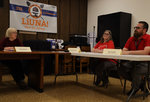


Sen. Patty Murray wants to make sure labor unions have power. She’s put forth a bill that she says will do as much, imposing penalties on businesses trying to find legal loopholes against union representation and strengthening unions’ right to strike, among several other things.
Murray came to Clark County last week to hear from local representatives of labor unions as she begins promoting her bill, the “Protecting the Right to Organize (PRO) Act” currently in the federal legislature.
“I’m here today because I have been very concerned about workers’ rights and the ability for people to gather together to fight for better pay, for workers’ conditions,” Murray said. “While we have seen the economy working really well for those at the top of corporations, I continue to hear from people at the bottom that their rights are eroding.”
The bill does a number of things with the goal of boosting unions’ power. According to the labor movement-aligned Economic Policy Institute, it would allow for greater ability for employees to organize, particularly without fear of retaliation by their employers, and would change the classifications of some workers currently titled as independent contractors, allowing them to participate in collective bargaining.
According to the more-skeptical Human Resources Policy Association, the act would be a “sweeping rewrite of American labor laws.” National Labor Relations Board Chairman Phil Miscimarra was quoted in information from the association saying the act “does not adequately consider the competing interests of employees, employers, unions and the public, which have been carefully balanced by Congress for important reasons in the past 80-plus years.”
Murray, however, fears that protections for workers offered through unions have deteriorated over the years. She said she has heard from a number of people who are “job scared.”
“They fear if they stand up and fight for their rights, the right pay, the right working conditions, that they’ll lose their job, and that’s not right in this country,” Murray said.
Individuals representing electrical and ironworking trades alongside one from the Northwest Regional Organizing Coalition told Murray their stories about how unions had helped them and other in their careers.
Two individuals representing the Battle Ground Education Association spoke during the roundtable, recounting their most recent work regarding a fight for pay raises for teachers that led to a 12-day strike at the beginning of the 2018-2019 school year.
Murray said she started her push behind the bill in Southwest Washington because she knew the area had been particularly impacted by union negotiations recently. Battle Ground teachers’ strike was one of many done by local school districts in the wake of a supposed “fix” to school funding brought on by state legislation that attempted to address the McCleary school funding case in the state supreme court.
BGEA President Linda Peterson said that striking was antithetical to what people in the teaching profession stood for.
“The whole reason you become a teacher is because you want to be in front of students, and you want to teach, and you want to make leaders out of them, impart all this knowledge and these lessons,” Peterson said. Though the decision to go to a strike was hard, it ultimately brought what she felt were worthy results. According to information from the district the average salary for teachers increased by 11.85% for the 2018-2019 school year.
Peterson recalled how until the past few years district teachers weren’t as organized. She said that after moving to a new bargaining model BGEA was 16 votes shy of a strike in 2016, adding that for many union members it was the first time they “had any inclination of what was being bargained, what we were talking about.”
“This was all very, very new to people who only wanted to be teaching in their classroom. They didn’t want to be doing this other stuff, this union work,” Peterson said. She added that standing up for what the union considered equitable pay had benefits outside of more financial security for teachers.
“When you are treated like a professional (and) you make a professional wage for what you have as far as your college credits, your experience, you feel better as a person, and that comes across in the classroom. That comes across to (students’) parents,” Peterson said.
“There was that fear, constantly, of, is the district going to retaliate? Are they going to find a reason to fire me?” Peterson said. She mentioned the district filed a court injunction to get teachers back to work, and with threats to cut insurance some teachers were worried.
After the roundtable, Peterson said that the district wasn’t retaliatory in their response, explaining during the formal discussion that the district was “following the playbook” when it came to their actions during the strike.
Peterson said she had teachers tell her the strike was the “most difficult, challenging, scary” yet “beneficial and exciting” time in their careers.
“It was probably the hardest job that I’ve ever had,” Jon Nesbitt, BGEA bargaining support lead, said. “It’s also something that I would absolutely do again if (I) felt the time was right.”
“We took the collective … 880 members that we had and turned them into one voice,” Nesbitt said, “Which was absolutely necessary to get a collective bargaining agreement that was fair and compensated everybody where they should be.”
“Ultimately, without the power of the union, I don’t think we would have made the same strides we were able to make here in Battle Ground, or (in) all of Southwest Washington,” Nesbitt said, referencing the several other districts that were on strike at the start of the school year.
As of the roundtable Murray said the gameplan for getting the bill passed involved getting co-sponsors in the Senate while a companion bill introduced into the House for consideration makes its own way. As of press deadline the bill had 39 co-sponsors in the Senate alongside Murray while the House version had about 100 sponsors in total.
Murray said that getting the public to understand what unions were would help to get the legislation passed.
“People just actually don’t know what a union is. It sounds like a big, powerful thing, and what it (actually) is, is all of you, standing together,” Murray said.